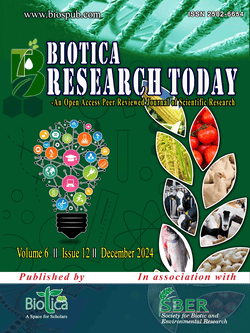
Tiger Widow and Sea Widow: The Tragic Story of Destitute Wives of Vulnerable Fishermen Community of Indian Sundarbans Mangrove Forest, a UN Heritage Site
Ajoy Saha*
ICAR-Central Inland Fisheries Research Institute, Barrackpore, Kolkata, West Bengal (700 120), India
Pranab Gogoi
ICAR-Central Inland Fisheries Research Institute, Barrackpore, Kolkata, West Bengal (700 120), India
B.K. Das
ICAR-Central Inland Fisheries Research Institute, Barrackpore, Kolkata, West Bengal (700 120), India
Pritijyoti Majhi
ICAR-Central Inland Fisheries Research Institute, Barrackpore, Kolkata, West Bengal (700 120), India
Piyashi Deb Roy
ICAR-Central Inland Fisheries Research Institute, Barrackpore, Kolkata, West Bengal (700 120), India
DOI: NIL
Keywords: Alternative livelihood option, Human-wildlife conflict, Indian Sundarbans, Tiger widows
Abstract
Sundarbans is the world’s largest delta and home for large numbers of wildlife animals including the endangered Royal Bengal Tiger. The exploitation of this area has increased as human dependency on forest resources is increasing. Consequently, human-tiger conflict in recent years also increased and in most of the cases, the victims are the male members. The saddest part is that women whose husbands are killed by tigers are stigmatized as "Tiger widows,” and seen as portents of bad luck. In addition to highlighting the numerous hardships endured by "Tiger widows," this article offers insights into alternate sources of income that could improve the lives of this unfortunate woman and the Sundarbans' vulnerable fishing community.
Downloads
not found
Reference
Chowdhury, A.N., Mondal, R., Brahma, A., Biswas, M.K., 2016. Ecopsychosocial aspects of human-tiger conflict: An ethnographic study of tiger widows of Sundarban Delta, India. Environmental Health Insights 10, EHI-S24899. DOI: https://doi.org/10.4137/EHI.S24899.
Dhar, S.B., Mondal, S., 2023. Nature of human-tiger conflict in Indian Sundarban. Trees, Forests and People 12, 100401. DOI: https://doi.org/10.1016/j.tfp.2023.100401.
Justin, S.J., Ghosh, D., 2022. A contemporary study of environmental challenges in Sundarban Tiger Reserve: A UNESCO world heritage site. EPRA International Journal of Multidisciplinary Research (IJMR) 8(12), 253-260. DOI: https://doi.org/10.36713/epra12112.
Mukherjee, S., Sarkar, P., 2024. Saline scars and broken levees: The impact of cyclones on Sundarbans’ agriculture and aquaculture. Biotica Research Today 6(4), 166-169.
